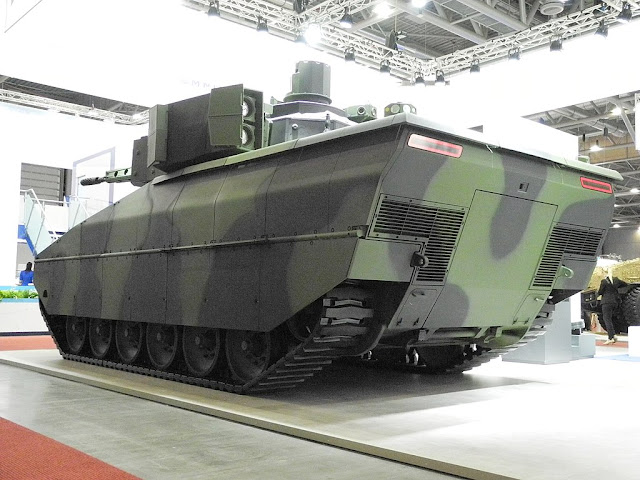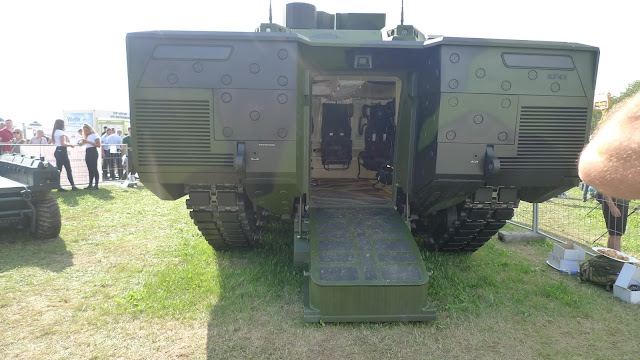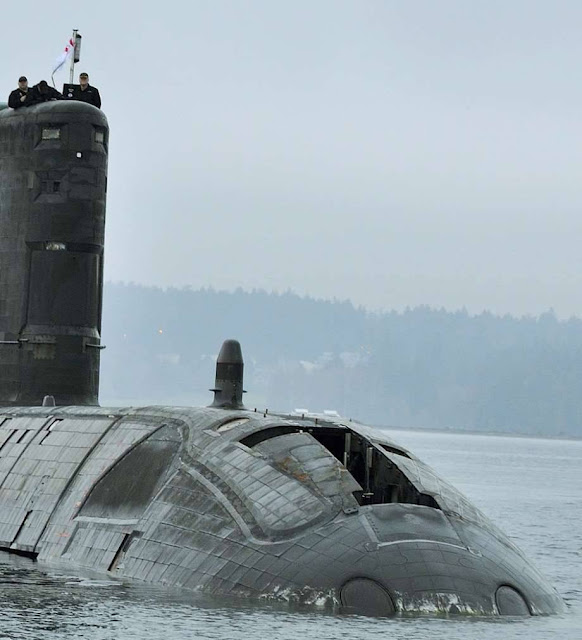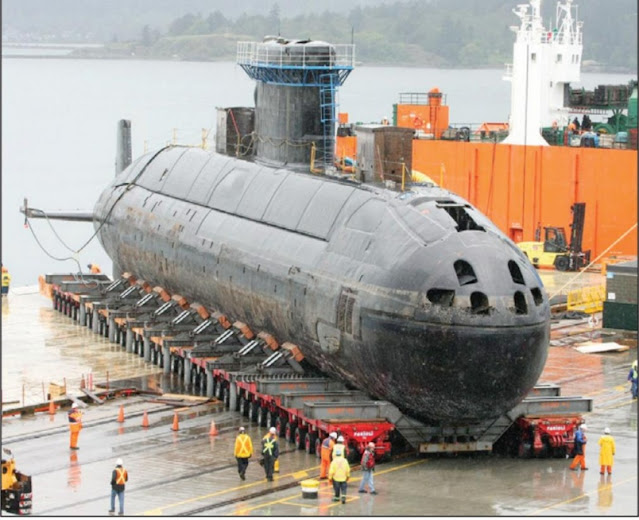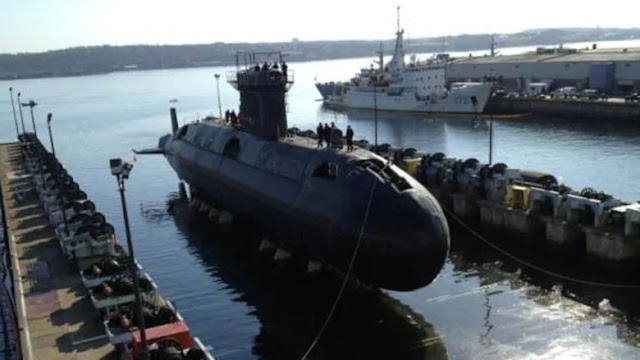Il Lynx è un veicolo da combattimento corazzato sviluppato dalla Rheinmetall Landsysteme (parte della divisione Vehicle Systems di Rheinmetall). Il Lynx, configurato come veicolo da combattimento della fanteria (IFV) KF31, è stato presentato pubblicamente alla mostra di difesa Eurosatory il 14 giugno 2016.
La variante KF41 è stata svelata pubblicamente alla mostra di difesa Eurosatory il 12 giugno 2018. Secondo Rheinmetall, la famiglia di veicoli corazzati cingolati Lynx è in prima linea in una nuova tendenza nella progettazione IFV verso veicoli blindati con costi unitari e di durata inferiori e complessità ridotta. Uno dei principi chiave del concetto Lynx è l'integrazione di sottosistemi collaudati con un livello di prontezza tecnologica elevato per ridurre i tempi di sviluppo, i costi e il rischio tecnico.
Sviluppo
La famiglia Lynx è stata progettata come veicolo blindato cingolato altamente protetto per colmare una lacuna identificata nel mercato dalla Rheinmetall. Il Lynx è stato progettato privatamente dalla Rheinmetall per fornire ai clienti un moderno veicolo da combattimento per la fanteria che sarà in grado di contrastare l'emergere di nuove minacce mantenendo la capacità di condurre operazioni asimmetriche o di mantenimento della pace. È stato mostrato pubblicamente per la prima volta nel giugno 2016 e nella configurazione più leggera KF31.
Il 4 giugno 2018 Rheinmetall ha emesso un comunicato stampa in cui informava che il più grande Lynx KF41 avrebbe debuttato due volte in diverse configurazioni alla prossima mostra di difesa. Dopo la presentazione in configurazione IFV il 12 giugno, il veicolo è stato riconfigurato come variante di comando, che è stata svelata il 13 giugno. La prima configurazione sarebbe come un veicolo da combattimento di fanteria con la nuova torretta LANCE 2.0, e poi, dopo il rimontaggio in loco, configurato come variante di comando.
A partire da maggio 2020 Rheinmetall aveva confermato che la società aveva proposto il Lynx in Australia, Repubblica Ceca e Stati Uniti. Inoltre, e secondo le trascrizioni delle chiamate degli investitori della primavera 2020, la società sarebbe stata nella fase finale dei negoziati con l'Ungheria in merito a un ordine di IFV per un valore di oltre 2 miliardi di euro (2,3 miliardi di dollari a maggio 2020), questi 210-220 esempi di Lynx. Rheinmetall ha annunciato formalmente un ordine ufficiale del governo ungherese il 10 settembre 2020 per 218 Lynx, confermando l'Ungheria come primo utente del tipo.
Design
Il Lynx è costruito attorno a uno scafo a forma di sponson con uno spalto lungo e poco profondo e una piastra sul ventre angolata. L'abitacolo è davanti a sinistra, il motore davanti a destra, il vano combattimento al centro (se dotato di una torretta) e c'è un vano di smontaggio nella parte posteriore, al quale si accede tramite una rampa nella parte posteriore del veicolo.
Una caratteristica fondamentale del concetto di design Lynx è la separazione e la modularità del veicolo in due parti principali:
- il veicolo di base e la missione specialistica
- e l'equipaggiamento del ruolo.
Le varianti Lynx sono progettate attorno a un modulo di azionamento comune con armature scalabili e opzioni di armamento su cui sono installati i kit di missione. I kit attualmente disponibili includono un IFV e un APC. Per i primi, una torretta è montata sul tetto dello scafo, per i secondi la torretta viene rimossa e sostituita da una piastra del tetto che include una serie di dispositivi di visione e un ROWS. Resta inteso che questa trasformazione può essere eseguita vicino o sul campo in otto ore. Le varianti future includeranno veicoli di comando, ricognizione, tutti armati con la torretta standard, oltre a versioni senza torretta tra cui riparazione, recupero, genio e ambulanza.
Secondo Rheinmetall, questo approccio progettuale combina i vantaggi funzionali, economici e di vita di una struttura modulare e i vantaggi in termini di peso, spazio e costo di un design integrale dello scafo.
Mobilità
Il gruppo motore situato nella parte anteriore destra è costituito da un diesel Liebherr accoppiato a un cambio automatico Allison X300 serie 6F / 1R o Renk HSWL 256. Il diesel Liebherr è di tipo common rail e dotato di turbocompressore a due stadi e intercooler a due stadi. La potenza varia da 755 CV (KF31) a 1.140 CV (KF41). Lo scarico (a destra) e il raffreddamento del motore (a sinistra) sono convogliati nella parte posteriore del veicolo per ridurne la traccia termica e acustica. I riduttori finali sono montati nella parte anteriore e le ruote dentate folli con tendi-cingolo sono montate nella parte posteriore. Il carrello ha sei stazioni delle ruote stradali per lato, che guidano un binario in acciaio leggero o elastico segmentato. Le ruote stradali in gomma sono montate su un sistema di sospensioni che comprende bracci oscillanti con barre di torsione convenzionali e sistemi di smorzamento SupaShock, questa configurazione si è dimostrata affidabile ed economica.
Il Lynx è dotato del maggior numero possibile di sottosistemi maturi per facilitare la manutenzione. La trasmissione KF41 è la stessa utilizzata nei veicoli Puma e Ajax, il motore Liebherr è ampiamente utilizzato nel settore edile e la postazione di guida è ripresa dal veicolo blindato Kodiak. Il sistema NBC è lo stesso installato sul Boxer e le piste sono identiche a quelle utilizzate sul PzH 2000.
I parametri di mobilità includono una velocità massima su strada di 70 km / h, una pendenza superabile di almeno il 60%, una capacità di superamento pendenza di almeno il 30%, la capacità di superare (in avanti) un ostacolo verticale di 1 m, la capacità di attraversare un 2,5 m di trincea e una profondità di guado non preparata di 1,5 m. L'autonomia con 900 litri di gasolio è di 500 km.
Il pilota si trova sul lato anteriore sinistro dello scafo ed è dotato di tre periscopi, uno dei quali può essere sostituito con un'alternativa di visione notturna. Il compartimento dell'equipaggio posteriore è progettato come uno spazio neutrale per la missione con l'incorporazione di binari a C e uno schema di punti di fissaggio universali sulle pareti e sul pavimento. Ciò fornisce una configurazione flessibile per tutte le apparecchiature specifiche della missione. Una grande rampa posteriore a comando elettrico consente un rapido ingresso / uscita.
Protezione
La corazzatura in acciaio balistico del veicolo è progettata per proteggere il Lynx da armi anticarro, munizioni di medio calibro, schegge di artiglieria e bombe. L'interno è dotato di un rivestimento anti-schiacciamento per proteggere l'equipaggio, mentre il veicolo dispone anche di sedili disaccoppiati oltre ai pacchetti di protezione IED che includono un doppio pavimento.
Il sistema di riscaldamento, raffreddamento e filtrazione nucleare, biologico e chimico è combinato in un sistema di controllo ambientale stivato nello sponsor sinistro posteriore di fronte al sistema di raffreddamento. I condotti dell'aria conducono al pavimento e all'interfaccia del condotto dell'aria all'estremità superiore dello scafo.
È possibile fornire una protezione attiva aggiuntiva per l' attacco di proiettili perforanti utilizzando il sistema di protezione attivo AMAP-ADS di Rheinmetall. È inoltre disponibile una gamma di protezioni passive e ausili difensivi. Includono un sistema di oscuramento rapido (ROSY), un sistema di allarme laser e un sistema di localizzazione acustico. Questi sono integrati nella torretta Lance quando è montata insieme al riconoscimento automatico del bersaglio e al tracciamento automatico del bersaglio.
Armamento
Il veicolo come mostrato è dotato di una torretta LANCE stabilizzata, alimentata esternamente, un cannone calibro 30 o 35mm, con munizioni airbust; ciò consente al Lynx di ingaggiare bersagli a distanze fino a 3.000 metri, sia quando è fermo che in movimento. L'armamento principale del veicolo ha un'elevazione compresa tra + 45˚ e −10˚ e ha una velocità di fuoco controllata di 200 colpi al minuto. Montata coassiale a destra vi è la Rheinmetall Machine Gun (RMG) da 7,62 mm, che può sparare munizioni NATO standard da 7,62 × 51 mm a una velocità di fuoco massima di 800 colpi al minuto. La torretta è dotata di backup manuale in caso di mancanza di corrente.
Il veicolo può anche montare un lanciamissili guidato anticarro opzionale. Il veicolo dimostrativo dell'Eurosatory 2016 era equipaggiato con un lanciatore a doppio giro per il missile guidato anticarro Spike-LR .
La variante IFV della variante KF41 mostrata all'Eurosatory 2018 era dotata della torretta LANCE 2.0 aggiornata, con pod di missione flessibili montati sui lati sinistro e destro in modo che una varietà di sottosistemi possa essere installata per fornire alla torretta capacità specialistiche
ENGLISH
Lynx is an armoured fighting vehicle developed by Rheinmetall Landsysteme (part of Rheinmetall's Vehicle Systems division). The Lynx, configured as a KF31 infantry fighting vehicle (IFV), was unveiled publicly at the Eurosatory defence exhibition on June 14, 2016. The KF41 variant was unveiled publicly at the Eurosatory defence exhibition on June 12, 2018. According to Rheinmetall, the Lynx family of tracked armoured vehicles is at the forefront of a new trend in IFV design toward armoured vehicles with lower unit and through-life costs and reduced complexity. One of the key principles of the Lynx concept is the integration of proven sub-systems with a high technology readiness level to reduce development time, cost and technical risk.
Development
The Lynx family has been designed as a highly protected tracked armoured vehicle to fill a gap identified in the market by Rheinmetall. Lynx was designed as a private venture by Rheinmetall to provide customers with a modern fighting vehicle that will be able to counter emerging near peer threats whilst maintaining the ability to conduct asymmetric or peace-keeping operations. It was first shown publicly in June 2016, and in the lighter KF31 configuration.
On June 4, 2018 Rheinmetall issued a press release informing that the larger Lynx KF41 would debut twice in different configurations at the upcoming Eurosatory defence exhibition later that month. Following the unveiling in IFV configuration on 12 June the vehicle was reconfigured as a command variant, which was unveiled on 13 June. The First configuration would be as an infantry fighting vehicle with the new LANCE 2.0 turret, and then after refitting on site, configured as command variant.
As of May 2020 Rheinmetall had confirmed the company had proposed the Lynx to Australia, Czech Republic, and the United States. Additionally, and according to Spring 2020 investor call transcripts, the company was reportedly in the final phase of negotiations with Hungary regarding an order over €2B ($2.3B in May 2020) worth of IFVs, these reportedly 210-220 examples of Lynx. Rheinmetall formally announced an official order from the Hungarian government on 10 September 2020 for 218 Lynx, this confirming Hungary as the first user of the type.
Design
The Lynx is built around a sponson-shaped hull with a long, shallow glacis and angled belly plate. The driver compartment is at the front left, the engine the front right, fighting compartment in the middle (when fitted with a turret) and there is a dismount compartment at the rear, access to which is via a ramp in the rear of the vehicle.
A key feature of the Lynx design concept is the separation and modularity of the vehicle into two primary parts: the basic vehicle and specialist mission and role equipment. Lynx variants are designed around a common drive module with scalable armour and armament options upon which the mission kits are installed. Available kits currently include an IFV as well as an APC. For the former, a turret is fitted to the roof of the hull, for the latter the turret is removed and replaced by a roof plate that includes an array of vision devices and an ROWS. It is understood that this transformation can be carried out near to, or in the field, within eight hours. Future variants will include command, engineer reconnaissance, and joint fires vehicles all armed with the standard turret, as well as non-turreted versions including repair, recovery, combat engineer, and ambulance.
According to Rheinmetall, this design approach combines the functional, cost and through life advantages of a modular structure, and the weight, space and cost advantages of an integral hull design.
Mobility
The power pack located at the front right consists of a Liebherr diesel coupled to either an Allison X300 series 6F/1R or Renk HSWL 256 automatic transmission. The Liebherr diesel is of the common rail type and fitted with a two-stage turbocharger and two-stage intercooler. Power output varies from 755 hp (KF31) to 1,140 hp (KF41). The exhaust (right) and engine cooling (left) are routed to the rear of the vehicle to reduce its thermal and acoustic signature. Final drives are mounted in the front and the idler sprockets with track tensioners are mounted at the rear. The running gear has six road wheel stations per side, which guide a lightweight steel or segmented rubber band-type track. The rubber-tyred road wheels are mounted on a suspension system comprising swing arms with conventional torsion bars and a SupaShock damper systems, this set-up is proven to be reliable and cost-efficient.
The Lynx is fitted with as many mature sub-systems as possible in order to facilitate maintenance. The KF41 transmission is the same as that used in the Puma and Ajax vehicles, the Liebherr engine is widely used in the construction industry, and the driver’s station is taken from the Kodiak armoured engineering vehicle. The NBC system is the same as that installed on Boxer and the tracks are identical to those used on the PzH 2000.
Mobility parameters include a maximum road speed of 70 km/h, a gradeability of at least 60%, a sideslope traverse capability of at least 30%, the ability to climb (forwards) a 1 m vertical obstacle, the ability to cross a 2.5 m trench, and an unprepared fording depth of 1.5 m. Operational range on 900-litres of diesel fuel is 500 km.
The driver is located to the left front side of the hull and is furnished with three periscopes, one of which can be replaced with a night vision alternative. The rear crew compartment is designed as a mission neutral space with the incorporation of C-rails and a pattern of universal fixing points on the walls and floor. This provides a flexible configuration for all mission specific equipment. A large power-operated rear ramp allows for rapid ingress/egress of dismounts.
Protection
The vehicle's ballistic steel armour is designed to protect the Lynx from anti-tank weapons, medium-caliber ammunition, artillery shrapnel and bomblets. The interior is fitted with a spall liner to protect the crew, while the vehicle also features decoupled seats in addition to mine and IED protection packages that include a double floor.
The heating, cooling and nuclear, biological and chemical filtration system is combined in an environmental control system stowed in the rear-located left sponson in front of the cooling system. Air ducts lead to the floor and to an air duct interface on the top end of the hull.
Additional active protection can be provided for shaped charge warhead attack using Rheinmetall's Active Protection System AMAP-ADS. A range of passive protection and defensive aids are also available. They include a rapid obscuration system (ROSY), laser warning system and acoustic shot locator system. These are integrated in the Lance turret when it is fitted along with automatic target recognition and automatic target tracking.
Armament
The vehicle as shown at Eurosatory 2016 is outfitted with a LANCE turret mounting a stabilized, externally powered, autocannon of 30 mm or 35 mm caliber, with airburst munition support. This allows the Lynx to engage targets at ranges of up to 3,000 meters, both when static and when on the move. The vehicle's main armament has an elevation of between +45˚ and −10˚ and has a controlled rate of fire of 200 rounds per minute. Mounted coaxial to the right is the latest Rheinmetall Machine Gun (RMG) 7.62 mm, which can fire standard 7.62 × 51 mm NATO ammunition and has a maximum rate of fire of 800 rounds a minute. The turret has manual back-up in case of power failure.
The vehicle can also mount an optional anti-tank guided missile launcher. The demonstrator vehicle at Eurosatory 2016 was outfitted with a twin-round launcher for the Spike-LR anti-tank guided missile.
The IFV variant of the KF41 variant shown at Eurosatory 2018 was fitted with the updated LANCE 2.0 turret, this having flexible mission pods fitted on the left and right sides so that a variety of subsystems can be installed to provide the turret with specialist capabilities.
Variants
The Lynx family of tracked armoured vehicles is based around two primary models, the KF31 and a slightly larger but considerably heavier KF41. Both models can be configured for a variety of roles that include command and control, armoured reconnaissance, surveillance, repair, recovery or ambulance operations in addition to infantry fighting vehicle configuration.
Kettenfahrzeug 31 (KF31)
This model, first displayed at Eurosatory 2016, has a maximum permissible gross vehicle weight of 35 to 38 tonnes, is 7.22 meters long and can carry a crew of three plus six passengers. Powered by a 563 kW (755 hp) engine, the vehicle can reach a top speed of 65 km/h.
Kettenfahrzeug 41 (KF41)
This model, as displayed for the first time at Eurosatory 2018, has a maximum permissible gross vehicle weight of up to 50 tonnes. The KF41 can carry a crew of three plus eight passengers. It is powered by an 850 kW (1,140 hp) engine and has a top speed of 70 km/h (43 mph). The KF41 is being offered to the Australian Army for the LAND 400 program.
Operators
Future operators
Hungary
On 17 August, 2020 the government of Hungary and Rheinmetall Group signed a contract to start manufacturing the Lynx infantry fighting vehicle family in Hungary. Few other details emerged at the time about the deal, which is part of Hungary’s Zrinyi 2026 rearmament programme launched in 2017. Hungarian Ministry of Defence sources stated to Janes on 19 August that the details of the package, including industrial and procurement aspects, would be worked out within one to two months. In a 2 September, 2020 interview about the new Lynx production joint venture and possible further German-Hungarian-Czech cooperation, Oliver Mittelsdorf, CEO of Rheinmetall Defence explicitly mentioned the existing, long-running manufacturing ties between Rheinmetall's MAN and Rába, a 124-years old Hungarian automotive manufacturing group with an active truck manufacturing plant near Győr, in Northwestern Hungary. A week later, on 10 September, 2020 Rheinmetall and the Government of Hungary held a joint press conference in Budapest and among the details of the new joint manufacturing project they announced that the new factory, along with an almost three square kilometer-sized full-service vehicle test track called ZALA Zone, will be built near Zalaegerszeg, Hungary. Rheinmetall's press release of 10 September, 2020 confirmed that the Hungarian Ministry of Defence had awarded Rheinmetall an order to supply tracked armoured vehicles and related products and services with a total value of more than €2 billion. The contract covers 218 Lynx infantry fighting vehicles fitted with Rheinmetall's manned 30mm Lance turret. The larger/heavier Lynx KF41 has been selected by Hungary. The award also includes nine Leopard 2 based Buffalo armoured recovery vehicles, plus additional products and services that include simulators, training and instruction, plus an initial supply of spare parts as well as maintenance support. During a first phase of production, Hungary is to receive forty-six Lynx plus the nine Buffalo ARVs, with delivery to be complete by the start of 2023. These vehicles will be built in Germany, but for the second production phase an additional 172 Lynx will built in Hungary. To this end, it was confirmed the Hungarian government and Rheinmetall had agreed in August 2020 to establish a joint venture responsible for creating a Lynx production facility in Hungary, to be financed by a local company.
Potential operators
Australia
Rheinmetall has submitted the Lynx KF41 for the Australian Defence Force's LAND 400 Phase 3 program (also known as the Mounted Close Combat Capability), the Request for Tender (RfT) for which was released on 24 August 2018. Land 400 Phase 3 will replace the Australian Army's M113AS4 armoured personnel carriers (APCs) with up to 450 infantry fighting vehicles (IFVs) and 17 manoeuvre support vehicles.[4][20] In mid-September 2019, Rheinmetall's Lynx KF41 Infantry Fighting Vehicle (IFV) and Hanwha's Redback K21 IFV were shortlisted for consideration for the Australian Army’s project Land 400 Phase 3 and will provide prototypes for a risk mitigation activity. Down-selection of a preferred tenderer that will be presented to the government for consideration is expected during 2022 and following that an initial operating capability of the selected platform is expected to be reached in 2024–2025, while final operating capability is expected by 2030–2031. Rheinmetall has also responded to a request for information on the procurement of another 117 vehicles under the Land 400 programme, these configured as logistics, mortar carries with direct fire capabilities, mortar ammo providers, and protected amphibious platforms.
Czech Republic
Rheinmetall submitted the Lynx KF41 for the Army of the Czech Republic's (ACR's) program to replace its current BVP-2, a Czech produced version of BMP-2. In November 2017 the Czech MoD completed field tests of four tracked AFV finalists and planned to select a winning platform by mid-2018, awarding a CZK50 billion contract for a mixed batch of 210 platforms with initial deliveries to begin in 2020. The ACR were reportedly very satisfied with the Lynx. In December 2018, Lynx was shortlisted together with the Puma, ASCOD and CV90. In October 2019 it was announced that the Puma was being withdrawn from the competition. The manufacturer said that the Czech Army requirements would require an expensive redesign to the existing Puma which it was unwilling to undertake. As of September 2020 no decision had been announced, however in March 2020 it was reported by Janes that the Czech MoD was preparing big cuts in defence spending as a result of Covid-19 and that the IFV award was threatened.
Qatar
In December 2018, a single Lynx KF41 was presented in the annual National Day parade badged and camouflaged as a Qatar Military Police (MP) vehicle. Rheinmetall declined to comment as to the nature of the vehicle’s presence at the parade.
United States
In October 2018, Rheinmetall announced a teaming with Raytheon to propose the Lynx KF41 to the U.S. Army in answer to its developing Next-Generation Combat Vehicle program, this slated to replace the Bradley Fighting Vehicles and other current platforms. This program, now known as the Optionally Manned Fighting Vehicle program, was halted on 16 January 2020. The U.S. stated it was cancelling the OMFV prototyping competition in order to revisit the requirements and acquisition timeline. The OMFV was subsequently re-started and in May 2020 Matthew Warnick, the American Rheinmetall Vehicles managing director stated that the Rheinmetall teaming would continue to compete in the revised OMFV requirement, however he added, “Our proposal is not going to be the Lynx in its current form, as everybody saw at [the AUSA conference] two years ago … This is going to be revised and evolved, based on the final RFP [request for proposal] but it’s a great starting point given its next-generation attributes to meet the specific US Army requirements.” The US Army is currently expected to release the OMFV RFP and at the start of FY 2022 to select vendors to produce digital designs. In the second quarter of FY 2023, the army will then decide which teams will proceed into the one-year detailed design phase. By the start of the second quarter of FY 2024, the service will conduct a critical design review and select the vendors to build OMFV prototypes with plans to begin testing these prototypes in the second half of FY 2025, before making a final down-select in FY 2027.
(Web, Google, Wikipedia, You Tube)







